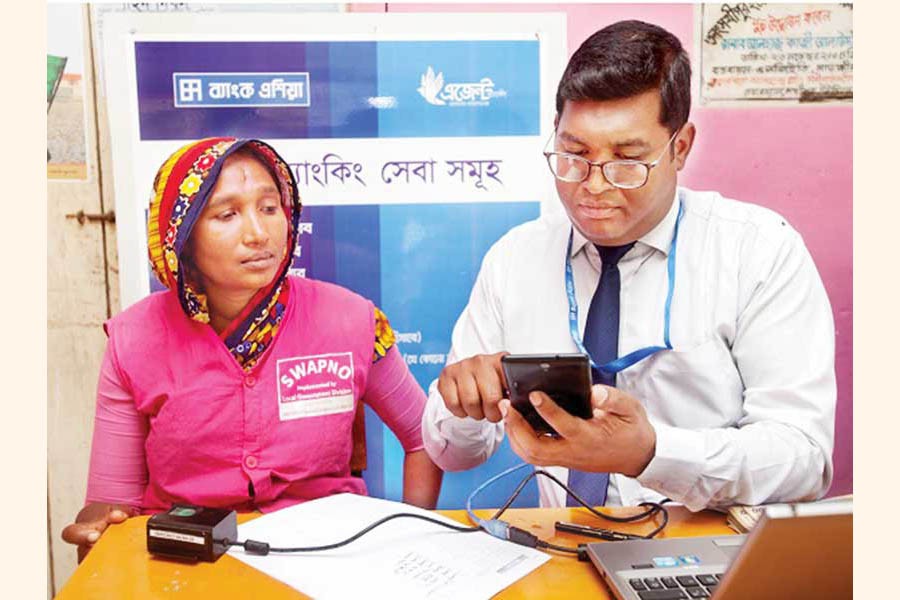
Reaching the unbanked: Can digital finance change the game?
Gultekin Binte Azad | Monday, 9 December 2019

 In this global network of communication, digitalisation and trade, financial inclusion of the unbanked masses is a widely discussed issue. This is because inclusive growth has recently become one of the world's most important policy goals. Governments, development partners, and economists have paid attention to the inclusion in economic and social life, including wider or universal access to education, health care, social security, clean water and sanitation, and affordable transport and electricity. Financial inclusion is the most recent item to be added explicitly to the social inclusion agenda and promotes the need for access among all segments of the society to a range of financial services at affordable cost.
In this global network of communication, digitalisation and trade, financial inclusion of the unbanked masses is a widely discussed issue. This is because inclusive growth has recently become one of the world's most important policy goals. Governments, development partners, and economists have paid attention to the inclusion in economic and social life, including wider or universal access to education, health care, social security, clean water and sanitation, and affordable transport and electricity. Financial inclusion is the most recent item to be added explicitly to the social inclusion agenda and promotes the need for access among all segments of the society to a range of financial services at affordable cost.
While financial inclusion is a recent term, it is clear from the historical economic trends that for many years our government has recognised the need for extending access to financial services. It has sought measures to promote it through public sector banks, agriculture credit programmes, and micro and small enterprise credit programmes. Much like its regional peers; Indonesia, India, the Philippines, Cambodia and Myanmar; who have adopted similar growth strategy, Bangladesh has realised the importance of bringing its huge unbanked population under the financial umbrella in order to truly attain sustainable financial growth.
The microfinance revolution, pioneered by the Grameen Bank in Bangladesh in the 1970s, focused on the reality that the formal financial system has not been successful in reaching the poor. Using peer monitoring and group-based approaches, microfinance agencies have shown that the poor are bankable and that innovative models can allow finance to benefit the poor. The narrow focus on credit has given way to a broader approach that includes micro-savings, micro-insurance, remittance and payment transfers. The most recent innovations include the related models of e-banking, branchless banking, and agency or business correspondent banking to overcome the barriers to distance and the high cost of setting up traditional bank branches in remote areas. In recent years, the governments have realised that specific financial programmes and agencies can only flourish in an appropriate policy environment. Thus, the last few years have seen the development of national financial inclusion master plans and strategies in many countries, along with the efforts to regulate microfinance agencies and the financial sector to better protect the users of their services so that the true benefits of inclusion can be achieved.
However, the true success of financial inclusion lies in two simple words: digital inclusion. Digital technology has already emerged as a game-changing enabler across many industries and is now beginning to create a similar impact on financial services. Digital financial services have the potential to make a large impact on financial inclusion, as already evidenced by progress in some African markets. This is because successful adoption of digital services will accelerate financial inclusion through their impact on existing business models. However, considering the infrastructure and adoption strategy of our country, there exists certain barriers; both cross-product and product-specific, which constrain financial inclusion.
Digital innovation has the potential to fundamentally change the provision of financial services to the underserved bottom of the pyramid masses, huge base of female workers especially garment workers, and micro small and medium enterprises [MSME] segments. As well as impacting the way in which traditional incumbents conduct their businesses, digital technology is being adopted by new entrants. They have the potential to disrupt and disintermediate, thus disaggregating the banking value chain. Examples of uses of the new technologies include the following.
* Alternative platforms such as mobile phones and digital platforms ensure last-mile access. These will be able to reach the financially excluded and people in rural areas without the need for physical bank branches. In light of this, the mobile banking services like Bkash, Rocket, Mcash, Ucash have become extremely popular in our country.
* Alternative digital information, such as biometrics data, to verify customer identity for account opening and payment authorisation.
* Analysis of transactional and digital footprint data to generate insights to improve customer targeting and credit risk assessment.
* Mobile wallets developed by non-banks, such as mobile network operators, to improve the customer experience in savings and payments.
Thus, in order to ensure success amalgamation, the below areas need to be addressed for digital solutions to have a positive disruptive impact on financial inclusion. It needs to be mentioned that the participation of new players, combined with the proliferation of new data, could also create new challenges for regulatory oversight.
* Demand-side entry constraints-digitally enabled customer identification and verification: Digital solutions can enable fast, low-cost, and convenient customer identification and verification process. This is especially so when the processes are powered by unique national IDs, a real-time verification infrastructure, and a supporting regulatory framework featuring tiered KYC and cross-product KYC. As an example, CIB system and smart national identity card based on the 10-digit unique identity number can help greatly reduce the time required for customer verification to less than a minute.
* Supply-side entry barriers - scalable delivery by tackling last-mile distribution: A key challenge for the financially excluded is their inability to access formal financial services through traditional banking infrastructure such as branches and ATMs. These are typically concentrated in high-density urban areas, and are much more limited in rural areas. Travel costs and opportunity loss add to the fees charged for banking services to present a significant cost constraint on the base of pyramid (BoP) segment. Digital technology can also meaningfully alter the supply side by addressing the problem of last-mile distribution and servicing. This can be done through alternative low-cost, widespread points of physical access that are digitally enabled, for example using mobile money or point of sale systems. Bangladesh is on track of addressing the geographical barrier by deploying mobile banking agents in every nook and corner of the country. Moreover, agent banking has been adopted in full swing since its formal declaration by Bangladesh Bank in 2013. These agent networks and point-of-sale terminals provide low-cost alternatives to branch banking, offering services such as cash-in and cash-out, bill payment, account transfers, credit disbursement, and collections.
* Payments and transfers-end-to-end digitisation: Gaining some kind of access to the formal payments network is a typical first step for an individual or smaller firm to become financially included.
Successful implementation of payment initiatives often results in broader effects too, by facilitating access to other financial services such as savings and credit, since loans are usually tied or linked to transaction accounts. The formal payments system is thus a way to deepen financial inclusion. There are certain ways in which payments and transfers can be digitally enabled.
Firstly, payments and transfers can be digitally enabled. Digitisation enables governments to disburse social transfers in an efficient, safe, and secure manner, and to reduce leakage. As the digitisation of remittance flows replace informal channels, it provides an initial platform from which the supply side can build an economically viable payments business. Once established, such a platform can be broadened to deliver other services, including P2G payments such as taxes, bill payments, mobile top-ups, and e-commerce purchases. Secondly, leveraging existing infrastructure can help introduce innovative, low-cost products and services. For example, in the case of a mobile money platform, such measures can facilitate payments for new services, providing consumers with additional product options, enhancing the value proposition, and increasing usage. Lastly, interoperability, for example, intra-and inter-bank, bank-MNO, and inter-MNO enables the ecosystem to leverage common payment rails, reducing duplication. It also provides more transaction options for end-users. When combined with simple, intuitive user experiences, it can drive transaction volumes significantly.
* Credit and fraud risk reduction via digitally-enabled data capture and analytics:
Digital technology can significantly enhance access to credit through the use of alternative sources of data, such as data from payment transactions and telecoms providers, combined with analytics. These can improve customer profiling, credit risk assessment, and fraud detection.
* Savings-cost effective mobilisation: By saving in the formal financial system, individuals can safeguard their money, earn a financial return, smooth their expense flows, reduce their dependence on credit, and build up account balances to enable them to deal better with shocks, for example, to cope with unexpected emergencies such as family illnesses. However, the BoP segment typically does not save formally for a variety of reasons. These include bureaucracy, cost, and physical and in some cases even cultural barriers.
By linking dedicated savings accounts to mobile money or e-wallets, users now can access a savings account at a licenceddeposit-taking institution and earn interest. The account can be automatically topped up using mobile money or cash stored in e-wallets. Similarly, money can easily be transferred out for payments using mobile or e-money. Moreover, increase cash-in and cash-out points can also help solve the problem. Agent networks enable individuals to access additional outlets for cash-in and cash-out. They can be supported by digital technology to enable providers to monitor liquidity in real time so as to ensure that agents do not run out of cash. Lastly, increased use of savings products can also be another key in tackling the problem of increased savings. Digital technology enables providers to offer customised and more-suitable products, such as commitment-based savings plans. It also enables savings product customisation, so that providers can offer goal-based savings accounts aligned with the savings models of the BoP segment.
* Regulatory oversight - data governance and customer protection: While digital innovation can provide a significant boost to financial inclusion, digital finance presents regulators with new challenges for achieving their objective of consumer protection. The supply-side ecosystem is changing rapidly and growing more complex, and risks are increasing related to data governance. In an increasingly digital world, there is an exponential increase in data generated by individuals' digital footprints. This includes information on whom they call, what they write in texts, whom they engage with on social media, and which websites they visit. The increase in data raises a variety of data governance issues relating to how data is accessed, used, stored, and shared. The BoP is a particularly vulnerable segment given its low awareness of these issues, its lack of alternative options and its challenges in effectively voicing grievances. Public policy will have a vital role in consumer education and protection. Suitable policies and regulations will be essential to articulate the responsibilities of supply-side participants and to ensure compliance. Specifically, guidelines will be needed for dispute resolution management, data standards and protocols, control mechanisms, and reporting requirements.
Thus, to wrap all up, the above issues discuss the impediments to achieving inclusive financial growth in true sense. Addressing them will not only help the escalation of inclusive growth, it will ensure the achievement of a true financially sustainable global village. However, lastly, to add to our beacon of hope, it is important to note that significant progress has been made in many areas, and that there are ongoing initiatives that will address some of the remaining issues in the coming years.
.........................................................
The writer is a Credit Risk Manager at The City Bank Ltd. She can be reached at gultekin060992@gmail.com